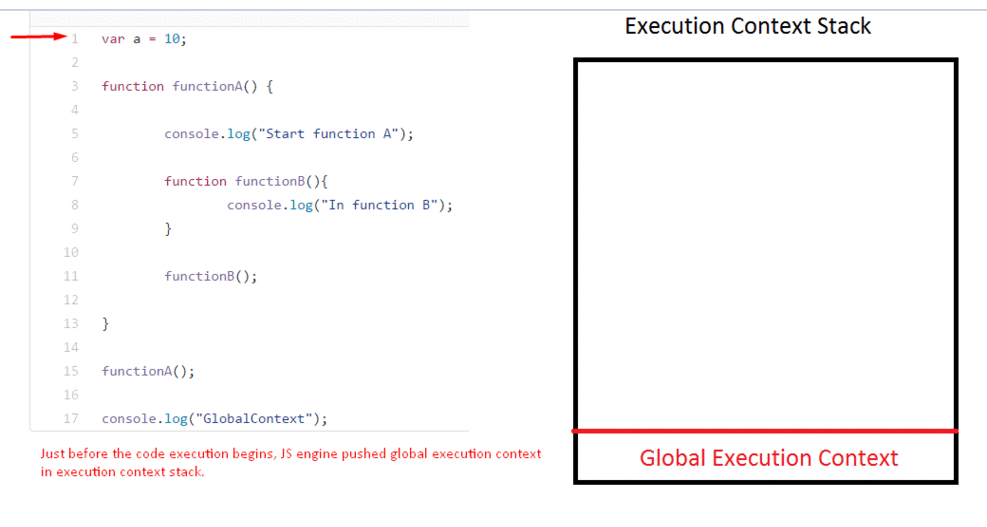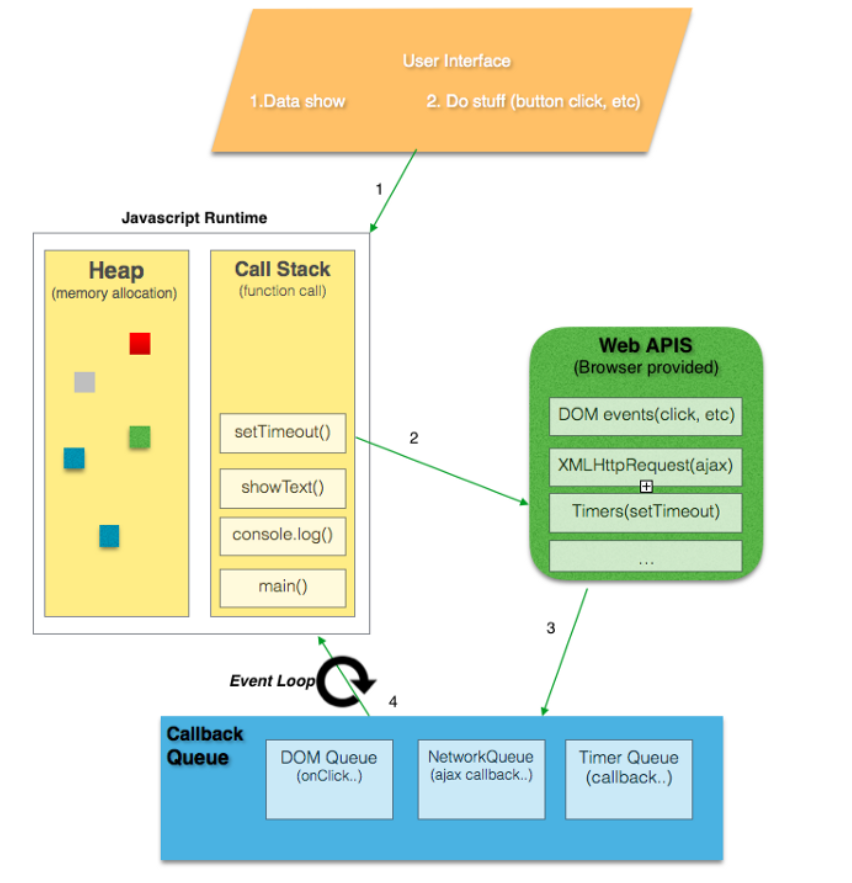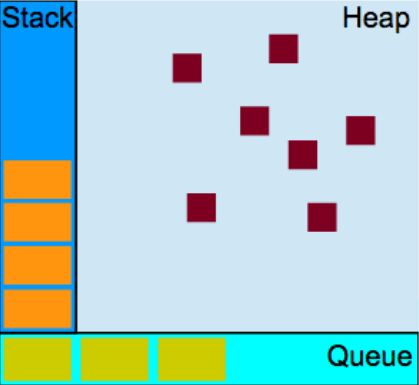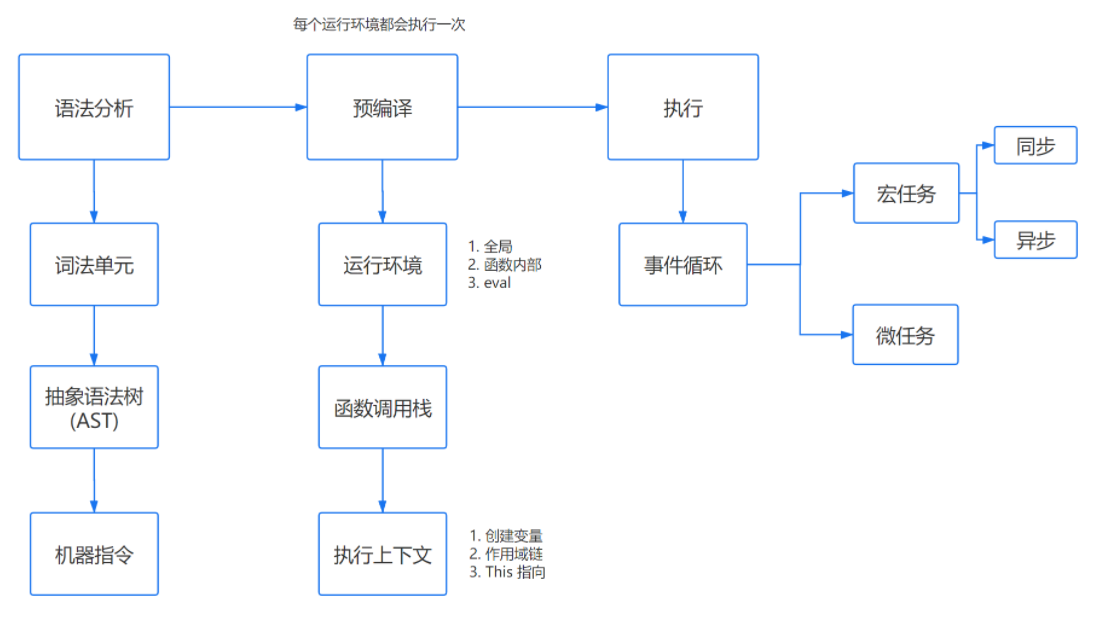这里是阅读完 js高级程序设计中的第10章以及第4章 做出的总结
重点部分的摘抄
1. 作用域,作用域链的理解
Scope : The current context of execution. The context in which values and expressions are “visible” or can be referenced. If a variable or other expression is not “in the current scope,” then it is unavailable for use. Scopes can also be layered in a hierarchy, so that child scopes have access to parent scopes, but not vice versa.
scope => Global scope and Local scope
Lexical Scope & function Scope
The scope chain of a function context is created at function call and consists of the activation object and the internal [[Scope]] property of this function
作用域对象:
本质就是函数定义所在的函数的局部变量存储对象(AO对象),如果在全局作用域下定义的函数,则为全局作用域对象。作用域链:
则是当前函数所有外层的执行上下对象的“局部变量存储对象”列表,也包含当前函数的“局部变量存储对象”(作为第一个元素)。
activeExecutionContext = {
VO: {...}, // or AO
this: thisValue,
Scope: [ // Scope chain
// list of all variable objects
// for identifiers lookup
]
};2. this 都有哪些情况
the value of
thisis determined by how a function is called (runtime binding).取决于执行时的上下文
function 类型: 构造函数 普通函数 箭头函数
- 默认绑定:全局 / 普通函数 - window - strict mode就undefined
- 隐式绑定:对象内函数
- 构造函数 跟new有关
- 箭头函数 this是继承
- 显式绑定: call apply bind
关于new操作符创建对象时发生的事情:
第一步: 创建一个Object对象实例
第二步: 将构造函数的执行对象赋给新生成的这个实例 call
第三步: 执行构造函数中的代码
第四步: 返回新生成的对象实例
3. 闭包的理解
闭包,即使函数是在当前词法作用域之外执行。
函数返回函数内局部变量的引用,导致函数执行结束后,其执行上下文对象依旧存在引用,无法被释放。外部就可以继续访问
闭包在js编程中随处可见,书中有这样一个结论:
在定时器、事件监听器、 Ajax 请求、跨窗口通信、Web Workers 或者任何其他的异步(或者同步)任务中,只要使用了回调函数,实际上就是在使用闭包!
立即执行函数,普通函数都会形成闭包
箭头函数 不是严谨的闭包
4. 改变函数作用域办法
- call apply bind
call apply 立即执行函数,参数有区别,apply 类数组,call 一个个参数
bind 返回函数,不会立即执行
- 包装为立即执行函数
(function foo() {
var a = 3;
console.log( a ); // 3
})();知识细节摘抄以及理解
执行上下文与作用域
CallStack又是也叫执行上下文栈(Execution Context Stack)- function/global/local

执行函数的过程:
先创建函数执行上下文(Execution Context)EC, 每个分为内存分配(Memory Creation Phase)与执行(Execution)这两个阶段,压入执行栈顶;
变量对象(Varibale Object) VO / Activation Object / this / arguments
执行函数函数。

这里我们拓展一下什么叫做js
JavaScript is a single-threaded non-blocking asynchronous concurrent language
a single-threaded: 只有一个
call stack,即one thread == one call stack == one thine at a timenon-blocking asynchronous:
EventLoop+callback queue
JavaScript 内存模型的角度,我们可以将内存划分为调用栈(Call Stack)、堆(Heap)以及队列(Queue)
每个 JavaScript 运行时都必须包含一个任务队列。当调用栈为空时,运行时会从队列中取出某个消息并且执行其关联的函数(也就是创建栈帧的过程)
这里对于js知识点熟悉的同学,可以看下面这个js编译执行的更加宏观的图
作用域增强
try/catch 以及 with 语句
很好的理解变量提升
其实这里如果能够很好地理解JS 机制,那么JS 的变量提升就能很好地理解
由于要在函数执行前创建函数执行上下文对象,所以函数内的局部变量都提前声明了。“变量提升”中的“提升”就是指创建执行上下文带来的“提前”行为。
JavaScript中的函数是一等公民,函数声明的优先级最高,会被提升至当前作用域最顶端,然后才是函数表达式和变量按顺序执行
let 有暂时死区,不会被提升
变量三个阶段: 声明(Declaration phase)、初始化(Initialization phase)与赋值(Assignment phase)
拓展实例
console.log(b);
b = 1;上面的语句将会报错,提示 ReferenceError: b is not defined,即变量 b 未声明,这是因为 b 不是用 var 命令声明的,JavaScript 引擎不会将其提升,而只是视为对顶层对象的 b 属性的赋值。ES6 引入了块级作用域,块级作用域中使用 let 声明的变量同样会被提升,只不过不允许在实际声明语句前使用:
> let x = x;
ReferenceError: x is not defined
> let x = 1;
SyntaxError: Identifier 'x' has already been declared垃圾回收机制
标记清理,引用计数
任何变量(不管包含的是原始值还是引用值)都存在于某个执行上下文中(也称为作用域)。这个上下文(作用域)决定了变量的生命周期,以及它们可以访问代码的哪些部分
代码执行流每进入一个新的上下文,会创建作用域链,用于搜索变量与函数
闭包 - 用完就销毁
函数声明 与 函数表达式
函数的定义通过函数声明或者函数表达式,function构造函数,创建具名或者匿名函数以及立即执行函数
函数声明 - 函数声明提升
console.log(sum(10, 10));
function sum(num1, num2) {
return num1 + num2;
}函数表达式
console.log(sum(10, 10));
var sum = function(num1, num2) {// 不可以用let
return num1 + num2;
};函数内部与递归
内部
arguments 、this 、caller(严格模式不可用,找回上层函数)、 new.target
检测函数是否使用new 关键字调用的new.target 属性
function King() {
if (!new.target) {
throw 'King must be instantiated using "new"'
}
console.log('King instantiated using "new"');
}
new King(); // King instantiated using "new"
King(); // Error: King must be instantiated using "new"递归
function factorial(num) {
if (num <= 1) {
return 1;
} else {
return num * arguments.callee(num - 1);
//return num * factorial(num - 1);
}
}函数尾部用优化
理解就是 最好用函数返回后不需要执行额外的逻辑,以及引用其他的值 或者 进行其他的转型运算
详细的JS引擎工作原理
绑定this失效
this在箭头函数中被绑定,4种绑定中的无论哪种都无法改变其绑定
var a = 0;
function foo(){
var test = () => {
console.log(this.a);
}
return test;
};
var obj1 = {
a : 1,
foo:foo
}
var obj2 = {
a : 2,
foo:foo
}
obj1.foo()();//1
var bar = foo.call(obj1);
//由于上一条语句已经把this绑定到obj1上,且无法修改。所以本条语句call(obj2)无效,返回的值是obj1.a的值1
bar.call(obj2);//1重点理解的题
1. 混合知识点的题
function Foo() {
getName = function () { alert (1); };
return this;
}
Foo.getName = function () { alert (2);};
Foo.prototype.getName = function () { alert (3);};
var getName = function () { alert (4);};
function getName() { alert (5);}
//答案:
Foo.getName();//2
getName();//4 因为变量提升与函数表达式,4会覆盖5
------------------------------------
区别在于 var getName 是函数表达式,而 function getName 是函数声明
函数表达式最大的问题,在于js会将此代码拆分为两行代码分别执行
console.log(x);//输出:f (){}
var x=1;
x = function (){}
console.log(x)//输出:f (){}
------------------------------------
console.log(x);//输出:function x(){}
var x=1;
function x(){}
console.log(x)//输出:1
------------------------------------
Foo().getName();//1 1覆盖4,返回this,指向的是window ===window.getName
getName();//1 window.getName
new Foo.getName();//2 ne(Foo.getName)();
//将getName函数作为了构造函数来执行
new Foo().getName();//3 点(.)的优先级高于new操作 (new Foo()).getName()
//返回this,指向new,实例的getName 是protitype
new new Foo().getName();//3 new ((new Foo()).getName)();2. let const var 声明区别
var和let/const的区别
块级作用域
不存在变量提升
暂时性死区
不可重复声明
let、const声明的全局变量不会挂在顶层对象下面
var a = 1; // 如果在 Node环境,可以写成 global.a // 或者采用通用方法,写成 this.a window.a // 1 let b = 1; window.b // undefined
const命令两个注意点:
- const 声明之后必须马上赋值,否则会报错
- const 简单类型一旦声明就不能再更改,复杂类型(数组、对象等)指针指向的地址不能更改,内部数据可以更改。
ES5只有全局作用域和函数作用域,没有块级作用域。
这带来很多不合理的场景:
- 内层变量可能覆盖外层变量
- 用来计数的循环变量泄露为全局变量
在块级作用域声明函数,最好使用匿名函数的形式。
暂时性死区和不能变量提升的意义在于:
为了减少运行时错误,防止在变量声明前就使用这个变量,从而导致意料之外的行为。
不允许重复声明变量
var f = true;
if (f === true) {
var a = 10;
}
function fn() {
var b = 20;
c = 30;
}
fn();
console.log(a);
console.log(b);
console.log(c);
// 10 报错 30
//这是个我犯了很久的错误,很长一段时间我都以为{...}内的新声明的变量是局部变量,后来我才发现function内的新声明的变量才是局部变量,而没有用var声明的变量在哪里都是全局变量。再次提醒切记只有function(){}内新声明的才能是局部变量,while{...}、if{...}、for(..) 之内的都是全局变量(除非本身包含在function内)。3. 代码理解
for (var i = 0; i < 3; i++) {
setTimeout(() => console.log(i), 1);
}这里的点是 块级作用域+全局作用域 & eventLoop(异步 - settimeout 函数)
4. 函数没有返回值时,返回什么?
function Person(firstName, lastName) {
this.firstName = firstName;
this.lastName = lastName;
}
const lydia = new Person("Lydia", "Hallie");
const sarah = Person("Sarah", "Smith");
console.log(lydia);
console.log(sarah);
A: Person {firstName: "Lydia", lastName: "Hallie"} and undefined
B: Person {firstName: "Lydia", lastName: "Hallie"} and Person {firstName: "Sarah", lastName: "Smith"}
C: Person {firstName: "Lydia", lastName: "Hallie"} and {}
D:Person {firstName: "Lydia", lastName: "Hallie"} and ReferenceError函数没有return的时候 return的就是undefined
这里一定注意 const不可能没有值!!!
this在箭头函数中的指向问题
function foo() { setTimeout(()=>{ console.log(this.a); // func },100); } foo.a = 'func'; var a = 'global'; foo.call(foo);You must be wondering how did the above code worked, and we didn’t even hard binded
thisfor the arrow function tothisoffoofunction!!!! 👺Well this is because the arrow functions do not have their own
this, so how come it printedfunc😱, this is because of the fact that, for arrow functionsthisis used using lexical scope lookup, which means that, when a reference tothisis made within any arrow function, the engine, will start looking up the scope of arrow function to find athisbinding, default being theglobal scopethis, so, when the above code is executed, during the callback, the engine, will first look forthiswithin the scope of arrow function, which it fails to find, then it traverses up the scope of the arrow function, which is the scope of the functionfoo, and since it finds athisin the scope of thefoo, that samethisis used as future reference within the arrow function, and sincethisoffoois hard binded to itself, we get the value ofthis.aasfunc.文章解释很全,总的说,跟红宝书讲的一样,箭头函数本身没有this,ES6新增的箭头函数在被调用时不会绑定
this,所以它需要去 箭头函数没有this绑定,往外层词法环境寻找。这里往外层 也就是书中说的继承
加深理解的例子(这里的例子来源网络,单个人理解与原作者的理解有出入 )
console.log('全局环境的this', this)
function test (){
console.log('方法中的 this', this)
function child(){
console.log('方法中的方法的 this', this)
}
child()
}
test()
var obj = {
name: "object",
doSth: function() {
var oName = "obj function name"
console.log('对象中的 this', this)
},
childObj: {
name: "childObj",
doSth: function() {
var arrow = () => {
console.log("对象中箭头函数的this", this)
}
arrow()
console.log('对象的对象中的 this', this)
}
},
doBibao: function() {
var count = 500
console.log('闭包构造方法的 this', this)
return function() {
console.log('闭包返回结果的 this', this)
}
}
}
obj.doSth()
obj.childObj.doSth()
var mbb = obj.doBibao()
mbb()
setTimeout(obj.doSth, 1800)
setTimeout(obj.doSth.bind(obj), 2000)
var fun = function() {
console.log('匿名函数中的 this', this)
}
fun()
class Vue {
constructor(options){
this.name = "vue"
this.type = "object"
this.options = options
console.log('构造函数的 this', this)
options.log()
}
}
var vm = new Vue({
log: function () {
console.log('构造函数找那个传递方法的 this', this)
}
})
function bibao (){
var count = 101
console.log('闭包外的 this', this)
return function() {
count++
console.log('闭包中的 this', this)
return count;
}
}
var bi = bibao()
console.log(bi())
var mArrow = () => {
console.log('箭头函数中的 this', this)
}
mArrow()
console.log('以下内容为异步执行')
setTimeout(() => {
console.log('延时箭头函数中的 this', this)
}, 1000)这里是又遇到一个挺好的文章推荐
this 测试题
var length = 10;
function fn() {
console.log(this.length);
}
var obj = {
length: 5,
method: function(fn) {
fn();
arguments[0]();
}
};
obj.method(fn, 1);
//window
//arguments
//obj变量提升
function fn(a) {
console.log(a);
var a = 2;
function a() {}
console.log(a);
}
fn(100);
//function a() {}
//2
//函数与var都能提升,函数先.



